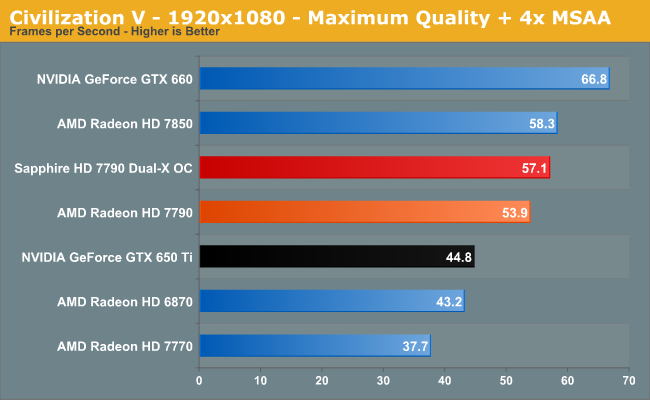AMD Radeon HD 7790 Review Feat. Sapphire: The First Desktop Sea Islands
by Ryan Smith on March 22, 2013 12:01 AM EST- Posted in
- GPUs
- AMD
- Sapphire
- GCN
- Radeon HD 7000
Civilization V
Our final game, Civilization V, gives us an interesting look at things that other RTSes cannot match, with a much weaker focus on shading in the game world and a much greater focus on creating the geometry needed to bring such a world to life. In doing so it uses a slew of DirectX 11 technologies, including tessellation for said geometry, driver command lists for reducing CPU overhead, and compute shaders for on-the-fly texture decompression.











107 Comments
View All Comments
ThomasS31 - Friday, March 22, 2013 - link
I dont think this is the Sea Island generation yet...Ryan Smith - Friday, March 22, 2013 - link
This is Sea Islands. Oland and Bonaire are both part of the Sea Island family.CeriseCogburn - Sunday, March 24, 2013 - link
Bonaire sounds (like Bel Air) all stuffy and prim and proper - too bad amd fanboys aren't classy.At least it's not pitcairn, the in the pit card.
KnightRAF - Monday, March 25, 2013 - link
Congratulations Cerise, between this article and the HTC One article you have succeeded in injecting so much pointless crap that it is no longer worth the effort to sift your crap out to read the actual comments on the article.extide - Friday, March 22, 2013 - link
PLEASE!!! Add folding@home benchmarks to your tests, please please!!Thank You!
JarredWalton - Friday, March 22, 2013 - link
Might want to read a little better before posting:http://www.anandtech.com/show/6837/14
extide - Tuesday, March 26, 2013 - link
Sorry, doh, I feel dumb. I quickly scanned the compute page and didn't see it. Thank you VERY MUCH for including these!!MrSpadge - Friday, March 22, 2013 - link
It's good to see clock & voltage states become more fine-grained and their choice smarter. Ultimately how I'd like a GPU to work: set targets and limits for power use, temperature and noise.. and then crank it up as far as it goes. Vary chips by different amounts of execution units, not frequencies.This includes simple user settings for lowering power consumption (call it the "green mode" of whatever), if people want to, which would automatically choose lower voltages to increase efficiency.
And of course something similar to nVidias frame rate target: if performance if fine now, save power. And save some thermal headroom in case it's needed soon. Make smart use of the power budget. It's nice to see AMD making some progress!
Termie - Friday, March 22, 2013 - link
Ryan, just FYI, you're using Catalyst 13.2 beta 7 with the other cards, not Catalyst 13.7 betas as indicated in the text on "The Test" page.Ryan Smith - Friday, March 22, 2013 - link
Whoops. Thanks.